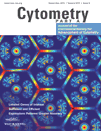|
Comments:
|
PBMC samples from patient and healthy donor
Blood was obtained from healthy donors (via Victorian Donor Blood Registry) and CLL patients (via Royal Melbourne Hospital, Australia). All patients consented under Melbourne Health HREC 2016.305 and samples were analysed under HREC 2016.066. PBMCs were isolated using standard Ficoll-based methods and cryopreserved.
Mass cytometry
Cells were thawed and stained for viability with cisplatin. Cells were then fixed with paraformaldehyde (PFA: Electron Microscopy Sciences, Hatfield, PA, USA) to a final concentration of 1.6% for 10 minutes at room temperature. Cells were pelleted and washed once with cell staining medium (CSM, PBS with 0.5% BSA and 0.02% sodium azide) to remove residual PFA and stored at -80?C.
Cells were barcoded using 20-plex palladium barcoding according to manufacturer?s instructions (Fluidigm, South San Francisco, CA, USA). Following barcoding, cells were pelleted and washed once with cell staining medium (PBS with 0.5% BSA and 0.02% sodium azide) to remove residual PFA. Cells were stained with CD16/CD32 for 10 minutes and surface antibodies (Table 2) for 30 min at room temperature. Cells were permeabilized with 4?C methanol for 10 min. Cells were washed three times with CSM and stained with intracellular antibodies (Table 2) for 30 min at room temperature. Cells were washed with CSM, then stained with 125 nm 191Ir/193Ir DNA intercalator (Fluidigm, South San Francisco, CA, USA) in PBS with 1.6% PFA at 4?C overnight. Cells were washed once with CSM, washed three times with double-distilled water and filtered to remove aggregates and resuspended with EQ normalisation beads immediately before analysis using a Helios mass cytometer (Fluidigm, South San Francisco, CA, USA). Throughout the analysis, cells were maintained at 4?C and introduced at a constant rate of ~300 cells/sec.
|

